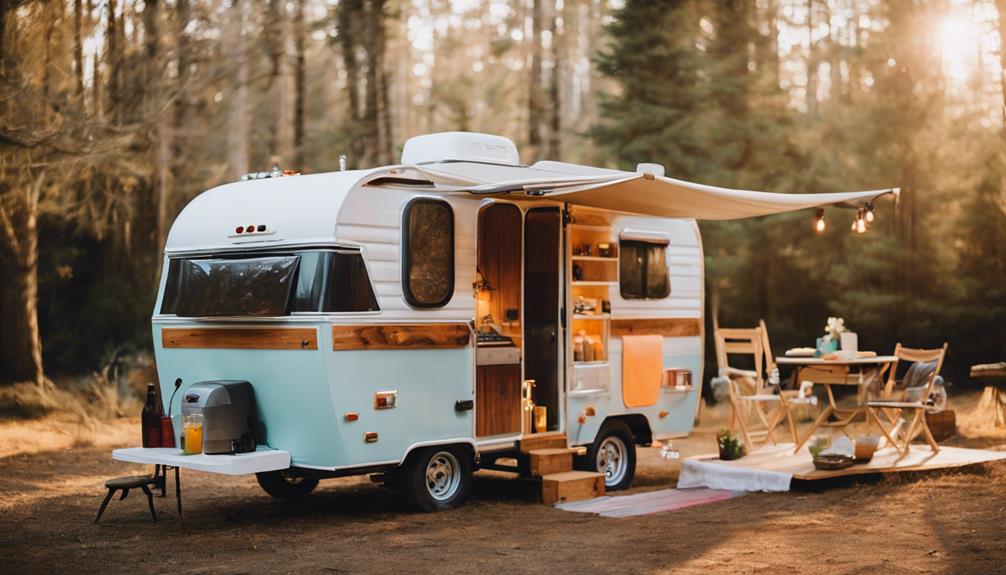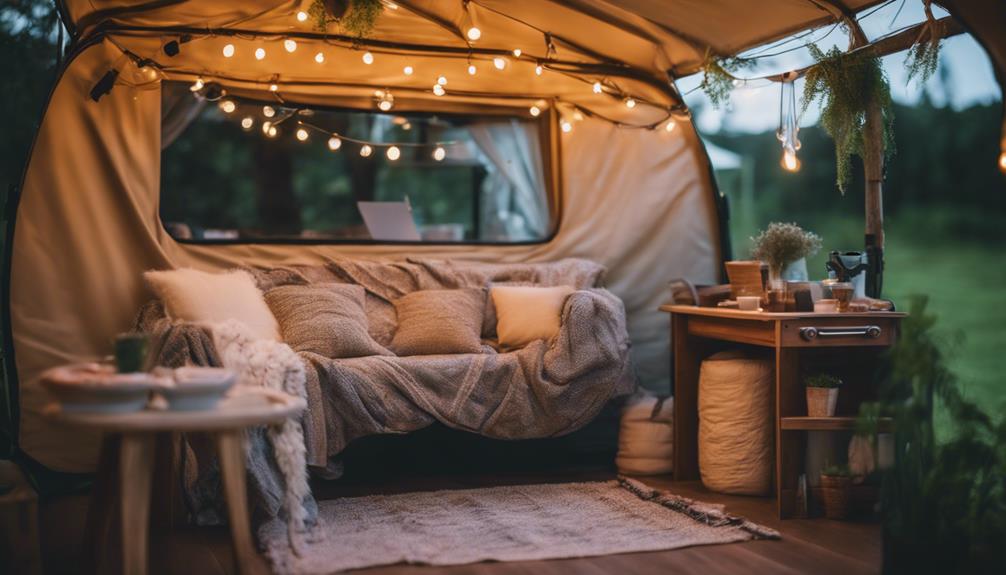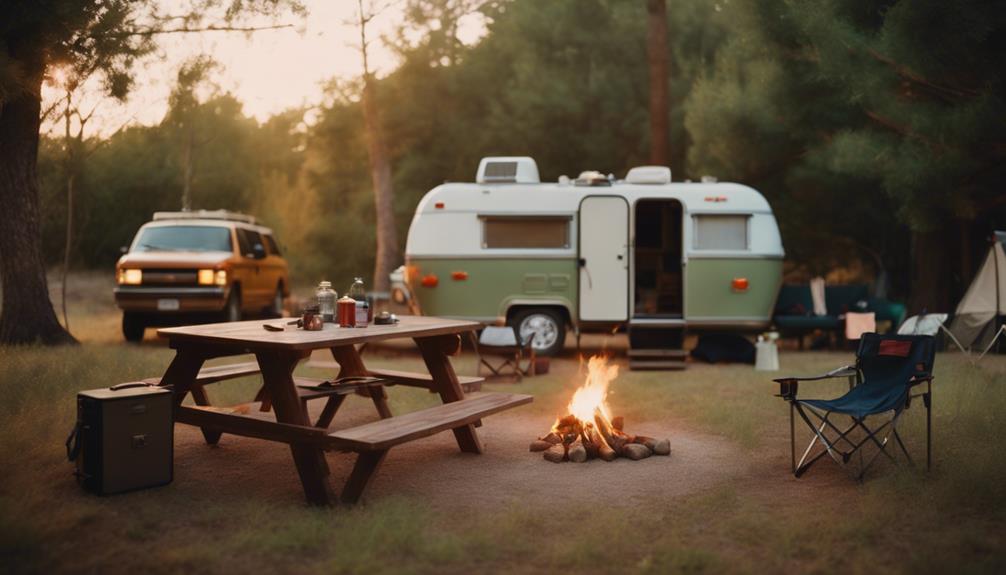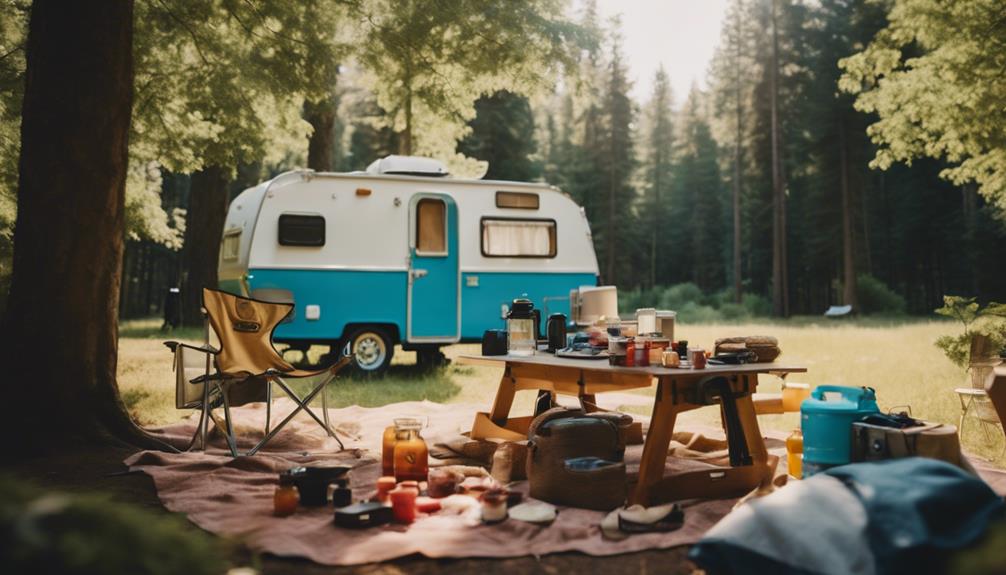To enclose your pop-up camper and create extra living space, start by evaluating the existing framework. Install insulated hard-sided walls and guarantee weatherproof seals to protect against the elements. Add insulation for better temperature control and comfort. Use durable roofing materials to enhance structural integrity. Incorporate multi-functional furniture and smart storage solutions to optimize space. Finally, don't forget to follow local regulations for safety. With the right approach, you'll not only boost livability but also elevate your camper's appeal. Discover more tips on maximizing your newly enclosed space and making it truly yours.
Key Takeaways
- Evaluate the existing framework to ensure stability before starting the enclosure process.
- Install hard-sided walls with weatherproof seals to prevent leaks and enhance insulation.
- Use insulated panels to improve temperature control and comfort throughout the year.
- Incorporate multi-functional furniture and smart storage solutions to maximize living space.
Benefits of Enclosing Your Camper
Enclosing your pop-up camper not only boosts living space but also enhances comfort for your family or group during trips. By converting your camper into a hard-sided structure, you gain significant benefits that transform your camping experience.
First and foremost, hard-sided enclosures improve insulation, giving you better temperature control and protection against harsh weather. This makes camping enjoyable in various climates.
Moreover, enclosing a pop-up camper increases its structural integrity, reducing the risk of damage from wind or rain. You'll feel more secure knowing your shelter can withstand the elements.
Additionally, an enclosed design typically comes with improved storage options. You can organize your gear and supplies more effectively, which is essential for long trips when space is at a premium.
Lastly, the aesthetic appeal of your camper will likely elevate with an enclosure. A well-designed pop-up can attract more interest from prospective buyers, potentially increasing its resale value.
Essential Materials and Tools
To successfully enclose your pop-up camper, you'll need a selection of essential materials and tools that guarantee durability and comfort.
Start with insulated panels for your walls, as they provide excellent thermal protection. For the roof, opt for durable materials like EDPM or metal to assure longevity. You'll also want to pick up some weather-resistant paint to protect the exterior from the elements.
As for tools, you'll need a saw for cutting your materials accurately, a drill for assembly, and a measuring tape to verify everything fits perfectly. A level is vital for checking the structural integrity of your build. Using metal studs instead of traditional wood can greatly reduce the weight of the structure while still providing robust support for your walls and roof.
Don't forget to have weatherproof sealants on hand. These will help you create airtight seals around windows and doors, preventing leaks and improving insulation.
Before you begin, make sure to check local building codes and regulations, as they may require specific materials or methods for your project.
With the right materials and tools, you're well on your way to creating extra living space in your camper!
Step-by-Step Conversion Process

Start by evaluating the existing framework of your pop-up camper, focusing on the four corner columns for added stability as you construct the hard walls. Remove the canvas tenting carefully, making certain to preserve the frame.
Next, replace it with hard-sided walls, guaranteeing you create weatherproof seals at the joints to prevent water ingress. Consider using lightweight materials like metal studs and sandwich panels. This will help maintain a balance between durability and weight, making your camper easier to tow.
Once the walls are up, install insulation within the walls to enhance thermal efficiency. This step is vital for making your converted camper suitable for all-season use.
After you've constructed the walls and added insulation, double-check that everything is securely fastened and weatherproofed. Finally, make certain to follow local regulations regarding modifications to campers. This guarantees that your new structure is compliant for safety and legality on the road.
With these steps, you'll transform your pop-up camper into a cozy, hard-sided retreat ready for your next adventure.
Space-Saving Tips and Tricks
After transforming your pop-up camper with hard-sided walls, it's important to maximize the limited space inside for a more enjoyable camping experience.
Start with effective space-saving tips like utilizing under-bed storage. This keeps seasonal or less frequently used items tucked away but easily accessible when needed.
Incorporate multi-functional furniture, such as a foldable table or collapsible seating, to create flexible living areas that adapt to your activities.
When it comes to organization, install vertical storage options like wall-mounted shelves or hanging organizers. This way, you keep frequently used items within reach while preserving valuable floor space.
Optimize your cabinet and drawer space by using stackable containers and tension rods. These tools help separate and organize smaller items effectively.
Don't forget about outdoor storage solutions. Weather-resistant bins or gear racks can keep your external equipment and supplies organized, preventing clutter from spilling into your camper's interior.
Enhancing Comfort and Functionality

Enhancing your pop-up camper's comfort and functionality is essential for creating a cozy, inviting space that meets all your camping needs. By making thoughtful upgrades, you can transform your camper into a delightful retreat. Here are three key improvements to reflect on:
- Foldable Walls: Installing foldable walls allows you to expand your living area while keeping the original framework intact. This way, you can enjoy more space without adding extra weight.
- Multi-Functional Furniture: Opt for multi-functional furniture, like a convertible dinette that turns into a bed. This maximizes utility and guarantees you have the flexibility you need in a compact space.
- Smart Storage Solutions: Incorporate storage solutions like under-bed compartments and wall-mounted organizers. These will keep your living space clutter-free and organized, making it easier to find what you need.
Additionally, upgrading insulation materials will enhance thermal efficiency, keeping you comfortable year-round.
Don't forget to install LED lighting to create a warm ambiance, making your pop-up camper feel like home wherever you roam.
Frequently Asked Questions
Can You Live Out of a Pop-Up Camper?
Yes, you can live out of a pop-up camper for short periods. With smart organization and storage solutions, meal planning, and regular maintenance, it can become a cozy space for your adventures.
Can You Insulate a Pop-Up Camper?
Yes, you can insulate a pop-up camper. Use materials like foam board or reflective barriers to improve thermal efficiency, reduce moisture, and enhance comfort during colder nights, making your camping experience more enjoyable year-round.
What Are the Disadvantages of a Pop-Up Camper?
Pop-up campers have limited insulation, making cold nights uncomfortable. Their canvas can leak or tear, requiring maintenance. They offer less storage and amenities, plus setup can be cumbersome, especially in bad weather. Stability issues arise in wind.
Can You Modify a Pop-Up Camper?
Imagine transforming your pop-up camper like an artist reimagining a blank canvas. Yes, you can modify it! Many enthusiasts successfully upgrade structures, improve insulation, and create unique designs while ensuring compliance with local regulations.
Conclusion
By enclosing your pop-up camper, you're not just adding space; you're creating a cozy retreat where memories unfold.
Imagine sipping your morning coffee while surrounded by nature, all in the comfort of your expanded living area.
With the right materials and a bit of effort, you can transform your camper into a versatile haven.
So why wait? Embrace the adventure, and let your enclosed camper become the backdrop for countless unforgettable moments.



















